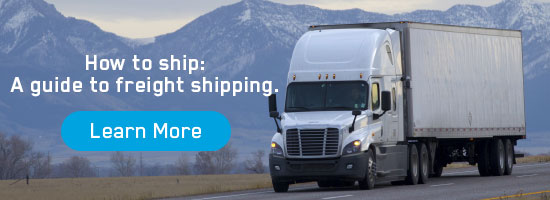10 most common freight shipping questions.
May 21, 2019

The freight shipping process can appear complex on the surface, especially to first time or small business shippers. While we all wish shipping freight could be as simple as sending a message in a bottle, the reality is, there are a number of regulations and processes in place to ensure valuable freight is safely delivered to its final destination.
So, what is freight shipping exactly? To help you better understand the shipping process from start to finish, we've outlined 10 of the most common freight shipping questions to get you started. Let's take a look.
Q: What can be shipped with freight shipping and what are my options?
A: Regardless of the amount of freight or its final destination, 3PL companies typically offer the services to handle it all. Common freight shipping options include truckload (TL), less than truckload (LTL), expedited LTL and intermodal. If you have questions regarding which shipping option best fits your needs, take a look at our post Freight Shipping: What Option Best Fits Your Needs?
Q: How are freight shipping rates determined?
A: Freight shipping rates are typically dependent on a variety of factors, including the type of freight being shipped, mode of transport, weight, distance and more. Here's a quick snapshot of how these rates are determined based on the selected shipping option:
- LTL. LTL rates are largely dependent on the freight class. Other fees are typically applied for additional services and actions like delivery appointments and liftgate services.
- Truckload. For truckload rates, the common determination is an amount per-mile which may or may not be inclusive of the fuel surcharge. Further charges may be added for things like detention and driver assistance.
- Flatbed. Flatbed rates are based on the type of equipment, mileage and total weight of the shipment. If there is oversized freight onboard, extra charges may apply and additional transit time could be necessary.
Q: What is a freight classification?
A: The freight classification system was created by the National Motor Freight Traffic Association (NMFTA) to provide a standardized freight pricing structure for all types of shippable commodities.
Commodities are grouped into 18 freight classes, signified as numbers between 50 and 500. The classification of your freight is determined by the weight, dimensions, density, ease of handling, value and liability (probability of freight damage or theft). Typically, the lower the class number, the lower the freight shipping price per pound.
Q: What is an NMFC number?
A: The NMFTA assigns a unique number to each shippable product. Wood finished tile, for example, has an NMFC number of 182355. Shippers and carriers use the NMFC number to correlate a product to a freight class which is used to calculate shipment charges.
Unsure of where you stand? Be sure to use our freight class calculator to identify freight class and plan accordingly.
Q: What is a 3PL?
A: 3PL is short for third-party logistics. 3PL companies, such as Freightquote by C.H. Robinson, attempt to take on every aspect of the freight shipping process. From the moment a shipper requests a quote for their shipment, all the way through delivery, these companies provide the necessary services and expert help.
Q: Can I estimate my freight dimensions and weight?
A: Freight dimensions and freight weight should never be estimated. It's critical to measure the length, width and height to the nearest inch, especially for LTL shipping, as these carriers rely on exact dimensions to determine how much freight can fit on one truck. Incorrect or estimated measurements could result in a costly carrier adjustment and other freight accessorial fees.
Much like freight dimensions, weight needs to be accurate as well. Freight carriers typically use the listed weight to determine how much freight can fit into an individual truck. The Department of Transportation (DOT) has truck weight regulations in place and incorrect weights will likely also lead to pricing adjustments.
Q: What's the best way to package my fragile goods?
A: When packing fragile items for a shipment, it's important to pack them with special care in order to avoid damage during the shipping process. While crating the fragile items is a necessary precaution, there are other things that can be done to further protect them, including:
- Wrapping items such as glass separately. This protects them from coming into contact with non-fragile items.
- Packing as many fragile items into one crate as possible so there is limited movement within the crate during transit.
Q: What is a BOL?
A: BOL in the freight shipping industry stands for bill of lading. This document works as a receipt of freight services, or a contract between the carrier and the freight shipper that provides all the necessary details to process and invoice a shipment correctly (date of shipment, number of units, freight classification, weight, etc.). The BOL is created and then presented to the carrier at pickup. The shipper retains a copy of the BOL for their own records.
Q: How do I ship hazardous materials?
A: The U.S. DOT considers any material that poses an unreasonable risk to health, safety or property as hazardous, and has classes in place to differentiate the types. Here are the different classes of hazardous materials:
- DOT Hazard Class 1: Explosives
- DOT Hazard Class 2: Gases
- DOT Hazard Class 3: Flammable liquids
- DOT Hazard Class 4: Flammable solids, spontaneously combustible materials, and materials that are dangerous when wet
- DOT Hazard Class 5: Oxidizers and organic peroxides
- DOT Hazard Class 6: Poisons and etiologic materials
- DOT Hazard Class 7: Radioactive material
- DOT Hazard Class 8: Corrosives
- DOT Hazard Class 9: Miscellaneous dangerous substances and articles
- ORM-D: Other regulated material
Before shipping these materials, the class must be identified and the shipper must find a carrier that meets all the DOT safety and transportation requirements.
Q: Can transit time of freight be guaranteed?
A: While freight shipping services are very reliable, shipments do not typically come with a guaranteed transit time unless it is requested. Pickup day is not included in the qualification and calculation of transit time.
Final thoughts.
While these aren't the only common questions and answers related to the freight shipping industry, we hope this post serves as a useful resource the next time your small business has freight to ship. If you’re looking to get started with a new freight shipping process of your own, head over to our Freight Management Services page to learn more.
Get Free QuotesTopics:
Get Your Shipping Quote



